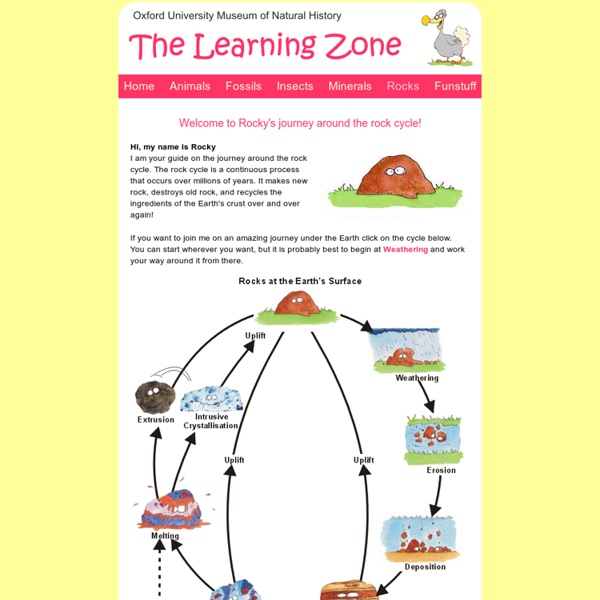



Geology.com: Rocks Lapis Lazuli Lapis Lazuli - a metamorphic rock and the most popular blue opaque gemstone in history. Tumbled Stones Tumbled Stones are rocks that have been rounded, smoothed and polished in a rock tumbler. Quartzite Quartzite a nonfoliated metamorphic rock composed almost entirely of quartz. Fluorescent Minerals Fluorescent Minerals and rocks glow with spectacular colors under ultraviolet light. Geology.com Store Gifts that Rock! Geodes Geodes look like ordinary rocks on the outside but can be spectacular inside! Trap Rock Trap Rock is a name applied to any dark-colored igneous rock used to produce crushed stone. Don*t Go To Jail Rock Collectors must know the rules before removing rocks from public and private property. Difficult Rocks Difficult Rocks Elementary students find lots of rocks that you will not be able to identify. Sand Grains A Grain of Sand Gallery of sand grains through a microscope by Dr. Sand Sand is a diverse material. Shale Siltstone Rock Tumbling Soapstone Rock Art Unakite Crushed Stone
The Rock Cycle . How Rocks Change Introduction Does it seem to you that rocks never change? For example, if you find a chunk of granite today, can you expect that it will still be granite at the end of your lifetime? That may well be true — but only because our lifetimes are very short relative to the history of the earth. If we take a step back to look at geologic time (which focuses on changes taking place over millions of years), we find that rocks actually do change! The way rocks change depends on various processes that are always taking place on and under the earth's surface. Heat & Pressure What happens to cookie dough when you put it in the oven? A similar process happens to rocks beneath the earth's surface. An additional factor that can transform rocks is the pressure caused by tons of other rocks pressing down on it from above; heat and pressure usually work together to alter the rocks under the earth's surface.
The Life Cycle of a Mineral Deposit—A Teacher’s Guide for Hands-On Mineral Education Activities This teacher's guide defines what a mineral deposit is and how a mineral deposit is identified and measured, how the mineral resources are extracted, and how the mining site is reclaimed; how minerals and mineral resources are processed; and how we use mineral resources in our every day lives. Included are 10 activitybased learning exercises that educate students on basic geologic concepts; the processes of finding, identifying, and extracting the resources from a mineral deposit; and the uses of minerals. The guide is intended for K through 12 Earth science teachers and students and is designed to meet the National Science Content Standards as defined by the National Research Council (1996). The process of finding or exploring for a mineral deposit, extracting or mining the resource, recovering the resource, also known as beneficiation, and reclaiming the land mined can be described as the “life cycle” of a mineral deposit.
National Geographic: Minerals, Gems Information More than 4,000 naturally occurring minerals—inorganic solids that have a characteristic chemical composition and specific crystal structure—have been found on Earth. They are formed of simple molecules or individual elements arranged in repeating chains, sheets, or three-dimensional arrays. Minerals are typically formed when molten rock, or magma, cools, or by separating out of mineral-rich water, such as that in underground caverns. In general, mineral particles are small, having formed within confined areas such as lava flows or between grains of sediments. Large crystals found in geodes and other rocks are relatively rare. Rocks themselves are made of clusters or mixtures of minerals, and minerals and rocks affect landform development and form natural resources such as gold, tin, iron, marble, and granite. Silicates—including quartz, mica, olivine, and precious minerals such as emeralds—are the most common class of minerals, as well as the major components of most rocks. Gemstones
Activity 3: Igneous Rocks - Bryce Canyon National Park Chemical CompositionChemical composition of igneous rock can often be estimated just from looking at the rock. Geologists look at the proportions of light-colored and dark-colored minerals in an igneous rock to estimate the chemical makeup of rock. Light-colored or felsic, minerals have more silica in them. Silica is one of the most abundant elements on Earth and is the chief component of quartz. Felsic minerals are most often colorless, white, gray or pink but can be any number of colors. The dark, or mafic, minerals are richer in iron and magnesium. The mineral proportions of the rock are what allows geologists to classify rocks chemically. Felsic rocks are high in silica (65% +). Instructional Procedures: Create colored tags for the students to wear. Discussion: What type of igneous rocks were formed? Extension: For teachers interested in rock identification, the following is a suggestion of how you can set up a rock-ID activity.
Rock Key The Rock Identification Key - by Don PeckRock Key Table of Contents What Are Rocks? Rocks are what the crust of the earth is made of. They are the mountains and the bottom of the ocean. [ Return to Rock Key Table of Contents ] What Minerals Form Rocks? Infographic: Potential vs. Kinetic Energy - KIDS DISCOVER Scientists define energy as the ability to get work done. The work can be anything from breathing to riding a bike to taking a nap. This free lesson sheet explains the two states for which all energy exists: potential and kinetic. Energy for iPad Packed with rich video and interactive animations, this app brings the topic of Energy to life, as kids discover the various sources and forms of energy we encounter on Earth, and how we as humans can better conserve our use of it. Video PreviewGet the app A Lesson in Potential and Kinetic Energy